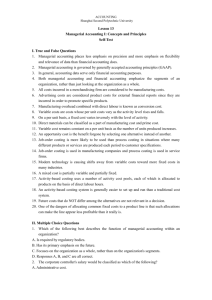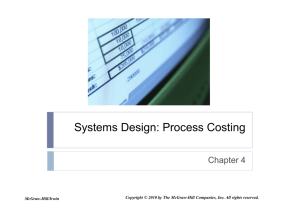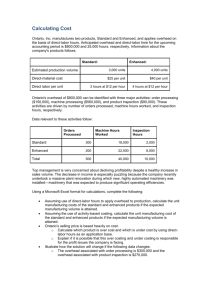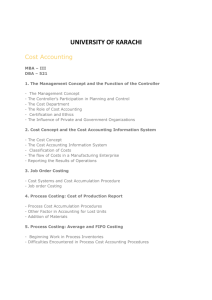job-order cost sheet
advertisement
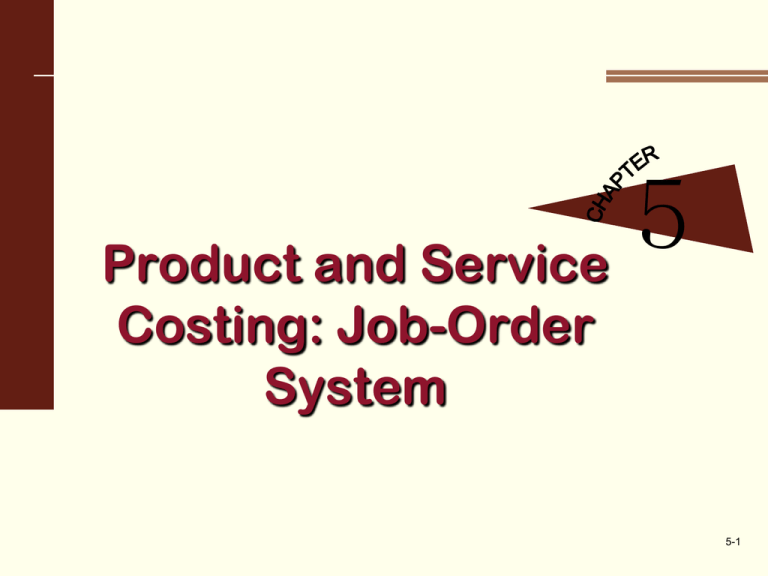
5 Product and Service Costing: Job-Order System 5-1 Characteristics of the Production Process 1 Manufacturing Firms versus Service Firms • Manufacturing firms • Combines direct materials, direct labor, and overhead to produce a new product. • Service firms • Provide a service. • So what is a beauty salon? Or a restaurant? • Both use tangible products, but both provide a service. • There are elements of both. 5-2 Characteristics of the Production Process 1 Manufacturing Firms versus Service Firms • Four qualities of a service. • Intangibility refers to the nonphysical nature of services. • Inseparability means that the production and consumption of the service happen at the same time. • Heterogeneity refers to greater variation in the performance of services than production of products. • Perishability means that services must be consumed when produced or provided. 5-3 Characteristics of the Production Process 1 Manufacturing Firms versus Service Firms • Ethics • Customers may perceive greater risk when buying services. • Manufacturers can offer warranties or product replacement. • A service that is unsatisfactory also costs the customer time. • Therefore service providers must be very careful to deliver what they promise. 5-4 Setting Up the Cost Accounting System 2 Cost Accumulation, Measurement, and Assignment • Cost Accumulation refers to the recognition and recording of costs. • A source document describes a transaction. A few examples of source documents are: • Purchase orders. • Sales receipts. • Time tickets. • Checks. • Deposit slips. 5-5 Setting Up the Cost Accounting System 2 Cost Accumulation, Measurement, and Assignment • Cost Measurement refers to classifying or organizing costs in a meaningful way. • There are two main ways to measure costs associated with production. • Actual costing uses actual direct materials, direct labor and overhead. • Normal costing uses actual direct materials and labor, but applies overhead using predetermined overhead rates or activity rates as discussed in Chapter 4. 5-6 Setting Up the Cost Accounting System 2 Cost Accumulation, Measurement, and Assignment • Cost Assignment refers to assigning the costs to units of production. • Once costs have been accumulated, measured and assigned, unit costs can be calculated. 5-7 Setting Up the Cost Accounting System 2 Cost Accumulation, Measurement, and Assignment • Unit costs are important to • Manufacturers for: • valuing inventory, • determining income, • and many other important decisions. • Nonmanufacturing firms for many of the same reasons. • Services do not need to value work in process or finished goods, but still need to determine profitability. 5-8 Setting Up the Cost Accounting System 2 Cost Accumulation, Measurement, and Assignment • Production of unit cost information • • Actual costing • Actual direct materials, direct labor and manufacturing overhead • Actual manufacturing overhead has timing problems. Normal costing • Actual direct materials and labor • Applied overhead based on a predetermined overhead rate. • Because the predetermined overhead rate is calculated using budgeted overhead and drivers, the timing issue is eliminated. 5-9 Setting Up the Cost Accounting System 2 Choosing the Activity Level • Expected activity level • Is the production level the firm expects to attain for the coming year • Normal activity level • Is the average activity usage that a firm experiences in the long term • Theoretical activity level • Is the absolute maximum production activity of a manufacturing firm. • Practical activity level • Is the maximum output that can be realized if everything operates efficiently. 5-10 The Job-Order Costing System: General Description 3 Overview of the Job-Order Costing System Costs are accumulated by job in a job-order costing system. Once a job is completed, the unit cost is determined by dividing the total manufacturing cost by the number of units produced. We assume that costs are applied based on normal costing. 5-11 The Job-Order Costing System: General Description 3 The Job-Order Cost Sheet The job-order cost sheet accumulates each job’s manufacturing costs. Each job-order cost sheet has a job-order number that identifies the new job. The cost sheet corresponds to a record in the work-inprocess inventory file. All the job sheets together form a subsidiary work-inprocess inventory ledger. A job-order costing system must be able to identify the quantity of direct materials, direct labor and applied manufacturing overhead. 5-12 The Job-Order Costing System: General Description 3 Materials Requisitions Direct materials cost is assigned to each job through the use of a materials requisition form. The form includes the description, quantity and unit cost of materials issued to each job. The form provides essential information for assigning direct materials costs to jobs, and also helps maintain proper control over a firm’s inventory of direct materials. 5-13 The Job-Order Costing System: General Description 3 Job Time Tickets Direct labor cost is assigned to each job through the use of a job time ticket. The form includes the name, wage rate and hours worked on each job. These forms are only used for direct labor. 5-14 The Job-Order Costing System: General Description 3 Overhead Application Jobs are assigned overhead costs with a predetermined overhead rate. Typically, direct labor hours are used as the measure to calculate overhead. Sometimes, another driver, such as machine hours, are used. In that case the actual amount of that driver must be collected and posted to the job cost sheets. 5-15 The Job-Order Costing System: General Description 3 Unit Cost Calculation Once a job is completed, the total manufacturing cost is calculated by totaling direct materials, direct labor and applied overhead. Then the grand total can be divided by number of units to produce a unit cost. 5-16 Job-Order Costing: Specific Cost Flow Description 4 Accounting for Overhead • Applied Overhead • • • Flows into Work-in-Process inventory through use of the predetermined overhead rate. Multiply the actual driver units used by the predetermined overhead rate to get Applied Manufacturing Overhead. Applied overhead is debited to Work-in-Process and credited to Overhead Control. • Actual Overhead • Actual overhead is debited to the Overhead Control account as it is incurred. 5-17 Job-Order Costing: Specific Cost Flow Description 4 Accounting for Finished Goods Inventory • Total job cost • • Direct materials, direct labor, and applied manufacturing overhead are totaled for completed jobs. The cost of a completed job is credited to Work-inprocess and debited to Finished Goods Inventory. • Schedule of cost of goods manufactured • • A schedule summarizing the cost flows through the production activity is prepared. Finished goods inventory is carried at normal cost. 5-18 Job-Order Costing: Specific Cost Flow Description 4 Accounting for Cost of Goods Sold • When the job is shipped • • To the customer, the cost of the finished job becomes a cost of goods sold. The cost of a completed job is credited to finished goods inventory and debited to Cost of Goods Sold. • Overhead variances • Cost of goods sold before adjustment includes the cost of the finished jobs that have been sold only. • There is usually an immaterial overhead variance which must be closed to the cost of goods sold account. After that adjustment takes place, the result is called the adjusted cost of goods sold. • 5-19 Job-Order Costing: Specific Cost Flow Description 4 Accounting for Cost of Goods Sold • Closing the overhead variance account • Usually done once a year. • Variances occur because of non-uniform production and overhead costs. • Over time these costs should largely offset each other. • If the end of year, variance is immaterial debit or credit the overhead control account to zero it out. The other half of the journal entry goes to cost of goods sold. 5-20 Job-Order Costing: Specific Cost Flow Description 4 Accounting for Nonmanufacturing Costs • Selling and general administrative expenses • These costs are period costs and never assigned to inventory accounts. • These costs flow to the income statement for the period. 5-21 Job-Order Costing with Activity-Based Costing 5 • Activity-Based Costing • A single rate based on direct labor hours may result in inaccurate cost assignments. • Departmental overhead rates and activity-based costing can be used with job-order costing. 5-22 Accounting for Spoiled Units in a Traditional Job-Order Costing System 6 • Normal Spoilage • Is expected waste due to the nature of the production process. • This is subsumed in the overhead rate and spread among all jobs. • Abnormal Spoilage • Is due to the exacting nature of a particular job. • This is charged to the particular job. 5-23
